#phagocytose
Explore tagged Tumblr posts
Text
Who's winning: 2145 or 4989




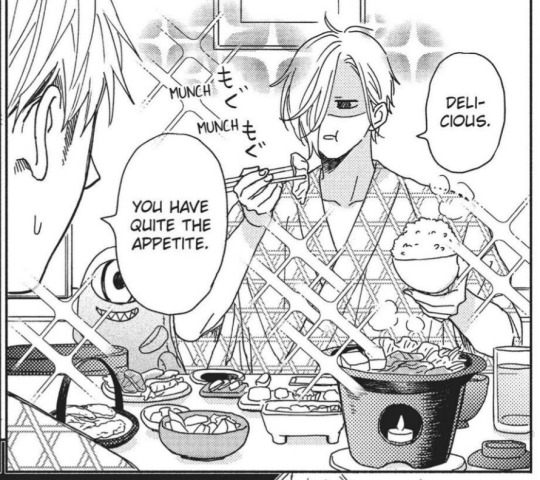
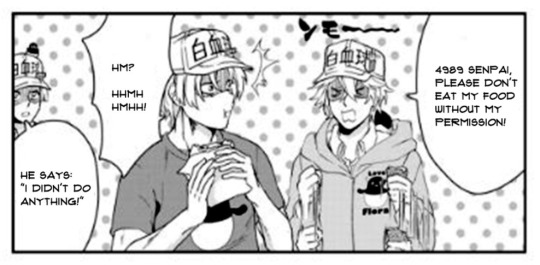
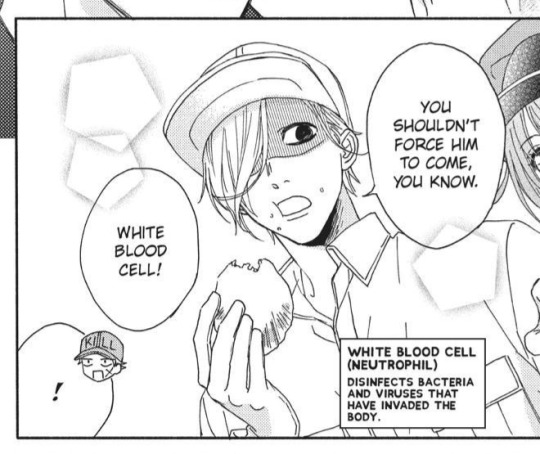
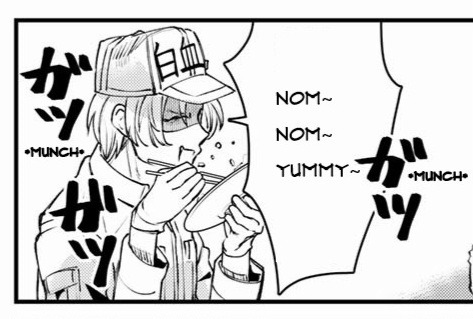
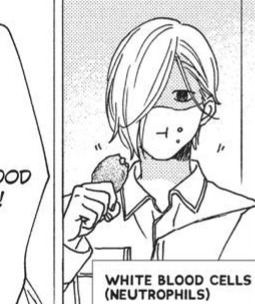
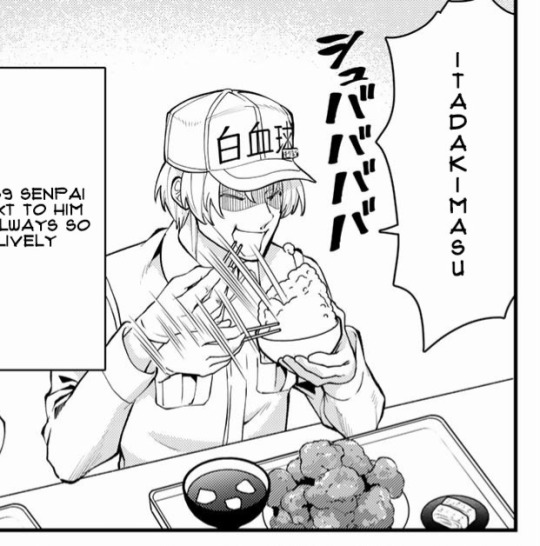
#cells at work#hataraku saibou#2145 is constantly eating more often but is said to do it in a workaholic way#4989 would phagocytose his own body if he could#both idiots in very different ways#the absolute absent minded look in both of their eyes give off completely different vibes
36 notes
·
View notes
Text
TO CONSUME IS (not) TO LOVE
cannibalism in romance novels
Cannibalism is like a parallax. For once it exists as a ‘philia’, characterized by the desire of eating another. And we find that it exists in the opposite spectrum, in the form of a ‘phobia’, which speaks of the fear of being eaten or partaking unknowingly or forcefully in the act of eating another. To vore is adjacent to love in most cases, both feared and desired. Because to love someone is (apparently) to want to consume them.
Though cannibalism might seem like a barbaric and horrific concept, it is said to be one of the most intense demostrations of love that exist in both classic and contemporary literature. The gruesome gesture reminds the lecturer of the intensity of love and its lunacy. As Mercedes Abad stated in spanish newsletter ‘el tiempo’ on May 21st, 1995 ‘There is no doubt that love and sex are feasts where, to a greater or lesser extent, we all become anthropophagi who would surely find it quite difficult to answer the question of whether there is greater pleasure in phagocytosing the other or in being phagocytosed.’ Because Cannibalism as a metaphor for love in romance novels, as it is in our day to day, is more about the blind consumerism of it rather than the pureness of it. One example of blind consumerism of love would be in Salvador Dali's Autobiography, where it is mentioned how Gala cooked their pet rabbit because of how much they loved it, in front of the woman’s refusal to the idea of leaving the rabbit with the maids.
To love is to consume, but to consume is to devour and transform in reusable energy. Like a vampire would when consuming someone’s blood, so they can continue living at the other’s cause. You live off the love you take, but if you devour that love, the other cannot live. The truth is cannibalism has a double connotation, and consuming the other’s otherness is three dimensional. Which means it isn’t always about love, or the lack thereof, but more so about the act of possessing. Cannibalism isn’t only one of the greatest manifestations of tenderness (for many), but also the irrevocably selfishness of an individual blinded by desire - in front of the morbid contemplation of the lover giving themselves so the other can survive -. The amorous-sexual instincts that resurface from a deep sense of infatuation together with those of hunger - a basic instinct - that create an irrational longing, unite in cannibalism as an analogy for that which we wish to become one with. It leaves you to question if the love narrated is but an act of survival for starved people.
‘Love is only a prologue to two cannibals struggling to take a bite of each other.’ - La Oscuridad, Ignacio Ferrando Perez (2014.) Cannibalism is, then, the imposture of love, and the obscure craving of something bigger than yourself without any understanding of it.
#canibalism#cannibalistic#cannibalism as a metaphor for love#cannibalism is the imposture of love#love#romance#classic literature#literature#analysis#mataphors#analogy#books#books and reading#my take on cannibalism#art is subjective#original post
309 notes
·
View notes
Text
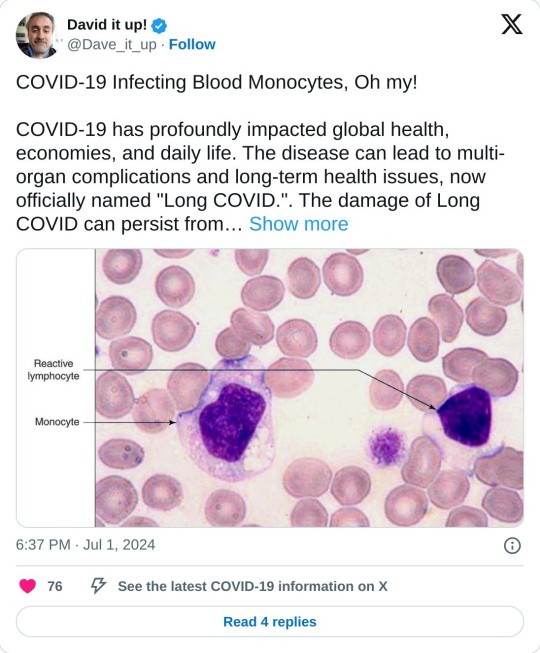
Another amazing post and explanation. Just click iee on Twitter.
COVID-19 has profoundly impacted global health, economies, and daily life. The disease can lead to multi-organ complications and long-term health issues, now officially named "Long COVID.". The damage of Long COVID can persist from months to years and include fatigue, shortness of breath, cognitive issues, and organ damage[1][4][7].
The Role of Monocytes in COVID-19
Monocytes are a type of white blood cell that plays a crucial role in the body's immune response. They are part of the innate immune system and are responsible for phagocytosing pathogens and presenting antigens to T cells. In the context of COVID-19, monocytes have been found to be significantly affected by the virus, leading to various immune dysregulations.
50 notes
·
View notes
Text
My brain will not let go of this AU so:
CB Cells getting transfused into Friends HC (?)
CB1 refers to the first body, CB2 refers to the second body. Assume none of the main group died because I will not accept this tragedy. They're put in friends for a REASON. If you don't remember their names, here's a Twitter post showing all of them. Read more separator bc this post is LONG.
RBCS + U1196
CB1 cells probably get so traumatized. I can hear AA2153 SCREAMING so loud to try to not to get pulled away into some unknown environment. BD7599 would already have a plan for when this happens and tries to pull both his juniors back, but because he tries to get both of them, it fails and he falls into the syringe anyways.
1196 technically could've escaped (probably was far enough away not to get pulled in) but she can't let AA go, that's her twink. So she goes along anyways.
I'm honestly surprised they never show what it looks like inside the syringe, centrifuge or blood storage. AA would knock on the plastic to try to get back out, he's the last one to pass out from the cold. I don't think they'd be conscious during the centrifuge, but imagine waking up to see you're all bunched up tightly with all your coworkers, that's crazy.
First one to wake up would also be AA, gets up screaming and looking around his surroundings expecting something horrible or grim. Only bad thing he figures out is that the body feels a little colder than he's used to. (Maybe Friends lost a bit too much blood in an accident.)
Wakes up and looks for his friends, CaWF blood cells see him and asks if he's okay (he's as pale as a ghost from how stressed he is) He doesn't hear them and continues looking anyways.
By the time he finds NC8429, BD is already conversing with the native RBCs. He doesn't even notice AA and NC until they tap his shoulder. I bet he'd be so glad they're alive he'd hug them fr.
1196 is killing off the bacteria that hitched a ride with the syringe. When she tries to phagocytose it she hits another neutrophil (2145) who's doing the same thing. They stare at each other for a second before 2145 cuts it in half to share it. 1196 is a little confused but hey, she got some, that's a win in her book.
They all still have a little PTSD so they're all a little flighty, F!RBCs welcome them a lot but AA is searching every capillary, vein and artery for something amiss. NC and BD are both suspicious of being transfused again but aren't as bad as AA. Once F!RBCs explain they were a bit shorthanded from a big bleed they probably stop being so worried about having to work in a bad environment.
CB2 gang have exactly no idea what to expect. They look around and are so confused because that's literally not where they were when they were last in the body. Somehow they got teleported to the entirely other half of the body?? They're in the oxygenated blood vessels despite last holding CO2???
Their map is entirely wrong now, they keep walking into vessels to be met with dead ends where a road should be, and walking into roads with tons of branches when it should be only 1 straight walkway. What confuses them even more now is how there are female RBCs along with only male neutrophils.
They'd also be shocked at how clean the vessels are, no rust, no residue, no scarring. I'm sure they'd figure out eventually they're in a different body.
Once they meet up with CB1 RBCs they rush off to finish their work (if this body needed a transfusion, it must need their help as soon as possible right?) By the end of the day they ran more laps around the body more times than they've ever had in a day because the blood pressure's good and the calves are actually doing their job and pumping blood like they should.
By the end of the day they probably feel so good with how easy it felt to do all of that. They try to do one last round before the lung cells are like "uh, guys? Y'all already finished your quotas for the next week, take a rest." The cells in Friends actually have reasonable work requirements and resting times, so the other RBCs are staring at them weirdly like "why are they going through their quota so fast?" "They want extra income from overtime or something?"
I think AA and DA4901 both try to fight the lung cell on that like "What do you mean?? You guys have oxygen right there, let us take it!!" And the lung cells like "uhh legally I can't do that, your colleagues want to do their job too y'know?"
BD is so pleasantly surprised, he even asks "So I can just, go home?? At 5 pm??" And confusedly the F!Lung cells ask him back "you need to ask for permission??" He pulls NC along with him to go explore the body's facilities and tries to pull AA with him but fails.
QJ0076 and SS1104 pass out on the floor. They're lying there while DA and AA ask around to make SURE that they can't do any more work. Some RBCs walk up to them very concerned that they don't have enough salary to afford an apartment or house and offer them to stay at their place.
At some point some F!RBCs ask for both of their contacts in case they (SS and QJ) need anything in the future. "Contact? What?" And the F!RBCs get even more concerned that they don't even have a phone. They offer to argue with their boss about salary before SS explains they're not native to the body so it's ok.
I think each group will share an apartment together at the start so they won't lose each other and also be able to save more money until they fully establish themselves into the body.
BD and NC already finished exploring the commodities of half the body by the third day while AA is walking and searching for 1196 (little does he know she's patrolling the lymph to get used to the body's vessels and migration routes because she's crashed into walls trying to migrate so many times it's getting embarrassing)
SS would also be exploring the body and maybe read more into the labor laws he never thought could exist, but get distracted by the various shops. QJ is following him and dragging him into various shops filled with delicious looking food
DA is running through the body with NO oxygen in his hands to burn his energy. Accidentally crashing into IM1235 and clamouring to help her pick up her oxygen because when that happens in his old body it'd be a big deal. 1235 tries calming him down because my god he's rushing and so anxious.
"you're one of the blood cells from outside!" And she quickly starts a conversation with him. Asks him if he's got any plans for the day and asks him to deliver her oxygen with her (he's so glad he met her bc of this)
She takes a break and brings him to the spleen but he's still worried about not doing his job enough. BD and NC are there too (by coincidence) they're all super confused by the spleen only having male hosts, DA is fine with it (bisexuality). BD wouldn't mind too much (he just talks to them casually like a guy) and NC wouldn't know what to think. They'd also call him cute.
DA gets distracted only for a bit so 1235 offers to let him deliver her oxygen (her delivering the box and he holds 1 tank of oxygen) Because he isn't used to having the energy to smile at the people he's delivered to, he always has that resting bitch face that scares the hell out of cells. 1235 will look like :D while he's just >: |
Eventually SS and QJ manage to buy a phone for each of themselves, along with urging the others to buy one for themselves too. AA was skeptical until they tell him he can use it to talk to 1196 whenever he wants, in which he then got one without another question.
1196 communicates with 2145 through 0% words and 100% staring and gestures. 3033 watches them like "what the fuck" and 2145 stares back at her and she's like "I know, right?"
AA might get the wrong idea at first bc 1196 is spending a lotta time with him, but it's okay, because 2145 is just helping 1196 integrate with the other neutrophils and explained (once again, without words) that his target is KT Squad leader.
She got a phone super early because HT thought getting her one is less trouble than having to get one of the other neutrophils to send his message to attack. The other neutrophils are super confused about how she detects antigens without a receptor, but eh, they don't judge her much for it.
AA loves to send her pictures everyday, at first he wasn't used to using it, so he kept taking blurry and out of focus images, but eventually got the hang of it and even managing to take selfies. She reacts to them like "wow" and "keep up the work" it sounds unenthusiastic, but she loves them.
QJ and SS fully exploring the limits of their phones spams gifs in the group chat whenever they have the free time (which is almost every day) and bothers DA by spamming him. DA (also not used to the phone) just sends "Stop." @ them (they don't stop)
SS makes fun of DA for not knowing how to use his phone but he's not that much better either, only just a few days ago when the KT squad asked him why his profile was blank when he realized he could change it. Also he's in the KT squad group chat, not because they added him in there but because he asked to be in there and wanted to see what they were talking about.
DA is the type of guy to not understand that to interact with his phone efficiently you just tap it lightly, so he always presses kinda hard into it and complains that it's really inconvenient. I think probably the same thing happens with BD but I think NC (who is way more proficient since he has less experience with ANYTHING so he absorbs knowledge easier) would be able to teach him
By next week they're finally allowed to deliver their own boxes again but their habits really, REALLY die hard. They try not to rush and enjoy the journey but they're already so used to sprinting across the body they think that a light jog is normal pace (it's not) so even though they tried not to Speedrun it, they still manage to finish it faster than what normal rbcs are supposed to do.
What's worse is on their days off, CB2 gang has no idea what to do because they've never had one before. SS is off to terrorize the KT squad again (he's like an even worse drill sergeant but this one isn't bound by the legal system to not mistreat them)
DA is sprinting around the body again until 1235 asks if he wants to join her girls only party. She knows he's not a girl but also, she knows he's kinda lonely so invites him anyways. He gets a silly bow on his head and his nails painted while all the other girls are looking at him a little confused.
"uh… RBC, he's not a girl… is he….?" "Oh no no!! It just sounded like he's never got to do something like this back where he was from so I wanted to show him!!"
He's happy about having a full 24 hour day to relax and have fun without worrying about ANYTHING, even if he is a little paranoid. He doesn't show it on his expression but I'm sure 1235 can tell he likes it. Not sure Abt the other girls tho.
1235 takes a photo with him together and tells him to send it to his friends to show them how much fun he's having. SS calls him a pretty boy while QJ is jealous he didn't get invited. DA still doesn't know how she got the image that she took with her phone, on his phone, and how he sent that image that he didn't take, to his friends.
POV: You are BD7599 asking the other senior RBC's why the spleen and liver only have hosts and no hostesses only to learn that in this body EVERY RBC is into men. Even the male presenting ones. Also you get hit on by other RBC guys.
I don't know which is funnier, making NC just a little gay and figuring out he is because of the hosts in the organs that host RBC's, or making him not into men at all and being stressed out about how to explain that to the super nice and gentlemanly hosts in the various organs.
AA tries out the liver's host bar after a moderate drinking night and has that exact same scene of him when 1196 comes up and covers his boner except he's with a guy instead and he's even more embarrassed.
SS loves minding the KT squad's business. Cross is stressing Abt what to message 3033 and he's like "c'mon, you literally kill for a living, how hard can it be??"
DA writing out things like "Closest glucose shop" "nearest vending machine" in the CB2 group chat bc he's confused.
They learn about video calls and lose their minds. SS tries to show the others the KT cells he's been tormenting but his hand is too shaky to see anything. DA looks like those old people who use a phone for the first time, putting it too close to his face. QJ manages to figure it out but accidentally presses the end call button and can't figure out how to rejoin the call.
Similar thing with CB1 but NC is actually using it properly while he's trying to teach BD how to angle his phone properly, and AA is holding it fine but he keeps aiming it at 1196 bc he loves looking at her.
DA asks around for a map of the body because he's still not used to the vessels and every RBC just advises him to look at his phone (he doesn't know that his phone has a map app) Only when he sees IM1235 open his app up to add in her address does he realize. "THERE WAS A MAP IN HERE THE WHOLE TIME??"
When they deliver to Dendritic cell he shows them ALL his beloved lactic acid bacterium. NC, SS and QJ find it cute and or impressive.
When they deliver to M cell and he spews his apoptosis thing. They turn to stare at DA when he says that he feels like it's barely worth it to keep living. Depending on how healed DA is he'd slap him and tell him to get it together or he'd be like "Yeah."
8 notes
·
View notes
Text
WE HAVE SOLVED THE MYSTERY OF WHY CELLS HATE NEUTROPHILS SO MUCH IN CAW
So, last night, my boyfriend and I got into some random discussion about programmed cell death and some new breakthroughs in medicine, you know, the usual things you talk about with your boyfriend at 1 AM. It is well known that leftover bodies of dead cells are phagocytosed (literally consumed) by macrophages. And that’s why I always wondered why aren’t cells scared of macrophages as much as they are of neutrophils, since neutrophils don’t consume the dead cells. With my limited understanding of immunity (which we technically don’t learn a lot about in biology) I thought that neutrophils only consumed invader bacteria and fungi.
And OH BOY was I wrong about that.
Because (and yes I have spent whole night researching this, I’ll provide the links to papers in the end lol) neutrophils are little freaks and not only do they phagocytose leftovers of cells they actually cause them to die in the first place. This happens during infections, especially with viruses that cause the excess release of cytokines (like Coronaviridae). Cytokines activate neutrophils who basically just follow the signal towards the infection site and there all hell breaks loose. Neutrophils phagocytose bacteria and virions (those are viruses that haven’t infected a cell yet) which is fine, but they also degranulate and NETose. I’ll explain this in simple terms to my best ability.
Degranulation is when granulocytes (neutrophils, eosinophils, basophils and mastocytes are all different granulocytes) release their granules which are kind of like little sacks inside their cytoplasm which contain various chemicals. Releasing these chemicals happens when the cell receives appropriate stimulus, the little granules expel their contents out of the cell’s interior. In the case of neutrophils, granules contain very toxic compounds that cause the formation of free radicals which damage DNA and proteins of the surrounding cells, as well as granules filled with digestive enzymes which, well, digest the surrounding tissues.
NETosis is a special type of cell death specific to neutrophils in which they literally degranulate pieces of their own, or their mitochondrial DNA together with more toxic compounds. This creates a net of DNA strands called chromatin which entangles invading bacteria and severely damages them and also marks them for phagocytosis by macrophages. But this process is not well controlled and some of that chromatin and toxic compounds can land onto neighboring cells which is, as you can conclude, very bad for them.
With these two abilities at hand, neutrophils are very well equipped to kill cells and destroy tissue. Which is good in cases when the cells are infected and the tissue is damaged, but their quite aggressive methods can damage healthy cells in the area as well, some of them will die and neutrophils will phagocytose their dead particles.
Basically, to neutrophils every infection is a huge kill and eat all you can buffet. They literally phagocytose until they physically cannot anymore and then go to the spleen or bone marrow to die. They also allow macrophages to consume them and thus pass on the antigens for antigen presentation which influences further immune response. But they can also cause a lot of damage, especially if cytokine storm happens and they completely lose control. This is what causes SARS and it can kill you if it’s severe enough.
Biologically speaking, neutrophils are very important because they are the first ones to come to the sight of infection and their crazy methods usually finish the things before they get too severe. They themselves produce cytokines that mobilize macrophages and dendritic cells so that more immune cells can join and help them. They also have a role in repairing the tissues they damaged.
However, other immune cells, including macrophages and killer T cells, simply don’t cause as much damage. Neutrophils just go all out, which is why they live for such a short period of time compared to their colleagues (they live for only few days, compared to macrophages who can live up to a month and lymphocytes who can live for months, even years).
So, yeah, my boyfriend and I have concluded (at 4AM this morning) that neutrophils are so feared because they damage tissue, go crazy and violently kill healthy cells by accident, then consume them and that’s not by accident, it’s a mechanism to repair tissues.
I can’t believe I wasted whole night just for this. My boyfriend is also disappointed. But I hope that we finally have an explanation for this mystery. Tell me what you think lol.
References:
https://www.ncbi.nlm.nih.gov/pmc/articles/PMC8589350/
https://www.nature.com/articles/nri.2017.105
https://www.ncbi.nlm.nih.gov/pmc/articles/PMC5820392/#:~:text=Neutrophils%20contribute%20to%20tissue%20injury,detail%20here%20(Kruger%20et%20al.
#cells at work#hataraku saibou#neutrophils#immunology#medicine#science#biology#i actually need help#it’s 4am
66 notes
·
View notes
Note
Hi!!! You help control diseases, right? I need advice! So I’m a macrophage, and earlier today I phagocytosed some bacteria I found near the intestinal epithelium. I thought I would be able to get rid of them no problem, but for some reason I can’t seem to kill them??? They’re just sitting there in my phagosome just—aaaaaaaah, I think they’re starting to divide now! Help!!!
Have you asked them to not?
27 notes
·
View notes
Text
Betting you guys do make a White blood cell list based on how much they actually seem to enjoy consuming the bacteria. All major wbcs. The main criteria is this:
1. Do they enjoy the taste of what they phagocytose (displayed by either facial expression or vocalizing it)
2. How often do they phagocytose?
3. Do they see it as a benefit of free meals or rather a duty to be done?
4. Vibes
You have 3 years. Don’t disappoint me
13 notes
·
View notes
Text
Fun fact one time in science class me and my friends were talking about phagocytose (i don’t actually know what it is in English) and one of my friends started saying “phago-” and stopped for some reason and it sounded like she said “faggot” and we all started laughing
9 notes
·
View notes
Text
Slime creature headcanons
Just because I like slime creatures.
When in a confrontation, slimes puff themselves up by incorporating bubbles of air; this allows them to look more voluminous and more opaque (for the same reason that snow is more voluminous and opaque than a block of ice made of the same amount of water), and therefore (in their hopes) have a more imposing presence. They can also do this to increase their buoyancy, in case they want to float on water.
Some slimes enjoy decorating themselves by phagocytosing objects they don't actually want to eat, such as glitter or glass beads. Some of them simply like holding and moving around these objects within themselves, much like one might like wearing a necklace one can fidget with. If you see a slime with an adventurer's skull or something inside it, it's possible that it isn't even the one who ate the adventurer, it just liked the skull.
If a slime creature has a house, then instead of chairs, beds or sofas, the house has bowls in it as comfort furniture. Sitting in a bowl is restful, because the slime doesn't have to make an effort to hold its shape to keep from flowing everywhere. Some textures of bowls are more comfortable to sit in than others. Those slimes who don't live in a house like sheltering in caves that have comfortably-sized bowl-shaped indentations for them to sit in.
4 notes
·
View notes
Text
BIOLOGY FACT #3
A friend of mine came up with this question while we were studying extranuclear inheritance.
“If most of the zygote’s cytoplasm is from the egg, then during meiosis where does the sperm’s cytoplasm go?”
I did a little research and found out that the majority of cytoplasm in a premature sperm (?) is phagocytosed (or I’d prefer, devoured) by neighbouring cells called Sertoli cells.
Also did a small illustration of the process. Not scientifically accurate, but cute.

0 notes
Text
If bacteria are food for protozoa
If bacteria are food for protozoa then who eats unicellular organisms
Do unicellular predators exist?
1.7-2.0 billion years ago
The first eukaryotes evolved (unicellular organisms with a cell nuclei). Some of these would have been “predators” feeding on other organisms. These are the ancestors of all higher life forms, living on Earth today.14 Dec 2022
Can a human be a unicellular organism?
Humans are multicellular. The cells of multicellular organisms have been specialized to perform various functions.
Is human sperm unicellular?
Is the sperm or an egg is a single cell or multicellular? Each sperm is a single cell.
How Do Cells Eat? - Ask A Biologist |
Arizona State University
https://askabiologist.asu.edu › how-do-cells-eat
24 Feb 2016
How Do Cells Eat?
Just like you, unicellular creatures need to eat. Unlike you, unicellular creatures don’t have mouths to eat with, teeth to chew with, or stomachs to digest with.
Cells eat other cells by engulfing them inside their cell membrane. This is called phagocytosis. The cell membrane of the predator cell will fold in or extend out to wrap itself around the prey cell. Once engulphed, the prey cell is contained within a special membrane-bound compartment called a phagosome. The predator cell can fill the phagosome with digestive enzymes to digest whatever prey is inside. Yum.
Below are two videos of predatory unicellular organisms; a ciliate and a heliozoan. When you watch the videos, take a look at how both predator cells have evolved structures that allow them to sense and catch their prey. Once caught, the prey is phagocytosed.
Sometimes these microscopic meals don’t behave as expected. Some cells, once they have been eaten, have the ability to evade the host’s digestive system. They can then live within the predator cell as a parasite, or as an endosymbiont.
It is being said that algae used to do photosynthesis
So life started which used to eat water, air and light
So were microbes the life after algae
Who were the first organisms, microbes or algae
Translate Hindi
अगर बैक्टीरिया प्रोटोजोआ का खाना है तो एककोशिकीय जीवों को कौन खाता होगा
क्या एककोशिकीय शिकारी मौजूद हैं?
1.7-2.0 बिलियन साल पहले
पहले यूकेरियोट्स विकसित हुए (कोशिका नाभिक वाले एककोशिकीय जीव)। इनमें से कुछ अन्य जीवों को खाने वाले "शिकारी" रहे होंगे। ये आज पृथ्वी पर रहने वाले सभी उच्चतर जीवन रूपों के पूर्वज हैं।14 दिसंबर 2022
क्या मनुष्य एककोशिकीय जीव हो सकता है?
मनुष्य बहुकोशिकीय हैं। बहुकोशिकीय जीवों की कोशिकाओं को विभिन्न कार्यों को करने के लिए विशेषीकृत किया गया है।
क्या मानव शुक्राणु एककोशिकीय है?
क्या शुक्राणु या अंडा एकल कोशिका या बहुकोशिकीय है? प्रत्येक शुक्राणु एक एकल कोशिका है।
कोशिकाएँ कैसे खाती हैं? - एक जीवविज्ञानी से पूछें |
एरिजोना स्टेट यूनिवर्सिटी
https://askabiologist.asu.edu › how-do-cells-eat
24 फरवरी 2016
कोशिकाएँ कैसे खाती हैं?
आपकी तरह ह��, एककोशिकीय जीवों को भी खाने की ज़रूरत होती है। आपके विपरीत, एककोशिकीय जीवों के पास खाने के लिए मुंह नहीं होते, चबाने के लिए दांत नहीं होते या पचाने के लिए पेट नहीं होते।
कोशिकाएं अन्य कोशिकाओं को अपनी कोशिका झिल्ली के अंदर समाहित करके खाती हैं। इसे फागोसाइटोसिस कहते हैं। शिकारी कोशिका की कोशिका झिल्ली शिकार कोशिका के चारों ओर खुद को लपेटने के लिए अंदर की ओर मुड़ जाएगी या बाहर की ओर फैल जाएगी। एक बार समाहित हो जाने के बाद, शिकार कोशिका एक विशेष झिल्ली-बद्ध डिब्बे के भीतर समाहित हो जाती है जिसे फागोसोम कहा जाता है। शिकारी कोशिका फागोसोम को पाचन एंजाइमों से भर सकती है ताकि अंदर मौजूद किसी भी शिकार को पचाया जा सके। यम।
नीचे शिकारी एककोशिकीय जीवों के दो वीडियो दिए गए हैं; एक सिलिअट और एक हेलियोज़ोअन। जब आप वीडियो देखें, तो देखें कि कैसे दोनों शिकारी कोशिकाओं ने ऐसी संरचनाएँ विकसित की हैं जो उन्हें अपने शिकार को महसूस करने और पकड़ने की अनुमति देती हैं। एक बार पकड़े जाने के बाद, शिकार फागोसाइटोसिस से गुज़रता है।
कभी-कभी ये सूक्ष्म भोजन अपेक्षा के अनुरूप व्यवहार नहीं करते हैं। कुछ कोशिकाएँ, एक बार खाए जाने के बाद, मेजबान के पाचन तंत्र से बचने की क्षमता रखती हैं। इसके बाद वे परभक्षी कोशिका के भीतर परजीवी या अंतःसहजीवी के रूप में रह सकते हैं।
कहा जा रहा है शैवाल प्रकाश संश्लेषण करते थे
तो शुरू की जो जीवन खाते थे पानी हवा और रोशनी
तो क्या माइक्रोब्स शैवाल के बाद के ही जीवन थे
कौन थे पहले जीव माइक्रोब्स या शैवाल
0 notes
Note
Im gonna phagocytose you if you don’t stop sending me asks
:3333333 what does that mean im too lazy to ask papa (also no i dont want to)
1 note
·
View note
Quote
Chimeric antigen receptor (CAR) T cell therapies have successfully treated hematological malignancies. Macrophages have also gained attention as an immunotherapy owing to their immunomodulatory capacity and ability to infiltrate solid tumors and phagocytize tumor cells. The first-generation CD3ζ-based CAR-macrophages could phagocytose tumor cells in an antigen-dependent manner. Here we engineered induced pluripotent stem cell-derived macrophages (iMACs) with toll-like receptor 4 intracellular toll/IL-1R (TIR) domain-containing CARs resulting in a markedly enhanced antitumor effect over first-generation CAR-macrophages. Moreover, the design of a tandem CD3ζ-TIR dual signaling CAR endows iMACs with both target engulfment capacity and antigen-dependent M1 polarization and M2 resistance in a nuclear factor kappa B (NF-κB)-dependent manner, as well as the capacity to modulate the tumor microenvironment. We also outline a mechanism of tumor cell elimination by CAR-induced efferocytosis against tumor cell apoptotic bodies. Taken together, we provide a second-generation CAR-iMAC with an ability for orthogonal phagocytosis and polarization and superior antitumor functions in treating solid tumors relative to first-generation CAR-macrophages.
A second-generation M1-polarized CAR macrophage with antitumor efficacy | Nature Immunology
0 notes
Note
I still can’t get over Mast cells being about to phagocytose. Imagine just being some cell near the skin with some dead bacteria killed by histamines or something and then just some cell, not even a white blood cell or monocyte is just like “oh, I got it :)” and then just eats it but way sloppier than a professional phagocyte.
Oh man Mast cells can phagocytose? I can imagine the Main's mast cell being embarrassed to do it in front of people, despite her enjoying the taste of bacteria. I like taking things that are in real life and applying them to our cells, send me more of these.
16 notes
·
View notes
Text
📆 Aug 2019 📰 Penetration of CD8+ Cytotoxic T Cells into Large Target, Tissue Cysts of Toxoplasma gondii, Leads to Its Elimination
Toxoplasma gondii is an obligate intracellular protozoan parasite that can establish a chronic infection in humans. One-third of the human population in the world is estimated to be infected with this parasite. The basis of the persistent chronic infection is the cysts, which can contain hundreds to thousands of bradyzoites surrounded by the cyst wall, in various organs, especially the brain. This chronic infection can reactivate in immunocompromised individuals, such as those with AIDS, neoplastic diseases, and organ transplants, resulting in life-threatening toxoplasmic encephalitis. Even in immunocompetent individuals, recent epidemiologic studies shed light on the pathogenic effects of this widespread chronic infection by reporting a higher incidence of multiple types of cancers in individuals seropositive to this parasite. Current chemotherapy is effective only against tachyzoites.

We investigated how CD8+ T cells remove tissue cysts of Toxoplasma gondii, which can grow to the size of >50 μm in diameter within infected cells. Notably, immunohistologic analyses in the brains of infected mice visualized the presence of numbers of CD8+ immune T cells that had migrated halfway through the cyst wall as well as T cells located fully within the cysts. Perforin was required for their invasion and cyst elimination. Cysts invaded by the T cells displayed morphologic deterioration and destruction. Within these deteriorated cysts, granular structures intensely positive for granzyme B were detected in association with T. gondii bradyzoites.
Furthermore, the bradyzoites within the destroyed cysts were located within accumulated ionized calcium binding adaptor molecule 1 (Iba1)-positive microglia and Ly6C+ macrophages, suggesting that these phagocytes had phagocytosed those organisms for their eradication. The present study uncovered a previously unappreciated capability of CD8+ cytotoxic T cells to penetrate into a large target, T. gondii cysts, their elimination. This invasive capability of CD8+ cytotoxic T cells in collaboration with phagocytes appears to be a powerful effector mechanism that functions against not only T. gondii cysts but also other large targets, including solid cancers.
0 notes
Text
The Innate Immunity Defense against Gastrointestinal Nematodes: Vaccine Development
The nematode parasite infects both humans and animals, causing severe infections. Their unusual surface structures, in particular, pose significant challenges to the immune system. Vaccine-induced immunity, mediated by the innate immune system, could be crucial in the development of an adaptive effector response. The purpose of this paper was to provide an overview of recent research on the host’s innate immune system, barriers, and cells that respond to parasitic nematodes. This study investigated the nematode-associated molecular patterns that may recognize by the host. Given that innate defense is more than just a static barrier against pathogen infections. It can actively contribute as a director of the adaptive immune response, which is ultimately responsible for the rejection of invasions. Some nematode parasites can actively move through tissues, and they pose a challenge to the innate immune system. Furthermore, their cuticular surface, which varies with each molting, cannot be phagocytosed. The nematode’s thin, carbohydrate-rich surface layer, as well as the chemicals produced by this layer, cause the first contact with the host’s innate immune system. It can be concluded that all components of the innate immune response can be activated and play an important role in the adaptive immune effector response.
0 notes